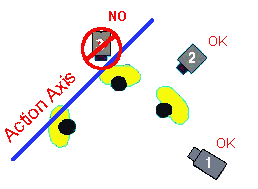|
Module 52 |
Updated: 08/25/2005 |
|
Solving As we've noted, audiences have learned to accept the technique of cutting out extraneous footage to keep a story moving. Strictly speaking, these are discontinuities in the action. While some discontinuities in action are expected and understood, some are not. When edits end up being confusing or unsettling, they are called jump cuts. If you are very observant you'll notice that many films and weekly television series provide good examples of minor continuity jumps in the action. Here are some examples:
These problems are primarily due to shooting in single-camera, film-style, where a significant period of time can elapse between scene setups and takes. We'll look at single-camera techniques a little later. It would be nice if potential jumps in continuity could always be noticed during shooting. New scenes could be immediately shot and we wouldn't need to try to fix things during editing. Sometimes, however, these problems only become evident when you later try to cut scenes together. Apart from costly and time-consuming re-shooting, there are some possible solutions.
|
|
Bridging Jumps in Action Let's start with how a jump cut in a dramatic production might be handled. Remember our young woman who was getting ready for a date? Let's say we see her hang up the phone in the kitchen and then head out the door to the bathroom. No problem yet. Let's now assume that after exiting the kitchen (moving left-to-right), the hallway scene has her immediately reaching the bathroom door from the right. Now she's moving right-to-left. The audience is left with a question: Why did she instantly seem to turn a full 180-degrees and start walking in the opposite direction to get to the bathroom? Although some directors and editors might not be troubled by this, others see it as an undesirable reversal in action and one that jars a smooth transition between scenes. The solution to most of these problems is to use the cutaways and insert shots we discussed earlier. With this particular continuity problem we could add a quick closeup of someone's hands (either hers or hands that look like hers) opening a linen closet and taking out a towel. Not only is a bit of visual variety introduced, but when you cut to her entering the bathroom we won't be as apt to notice the reversal in action.
If that didn't work, you might consider putting the scene of her in front of her closet deciding on her clothes before the bathroom shot. All of these tricks can be used to cover continuity problems.
Interviews are almost never run in their entirety. An audience used to short, pithy sound bites will quickly get bored by answers that wander from the topic, are less than eloquent, or that are... just boring. In interviews you may shoot ten times as much footage as you end up using. It's the job of the video editor to cut the footage down-
Not an easy job. To start with, cutting a section out of dialogue will normally
result in an abrupt and This assumes, of course, that you've already made a smooth audio edit between the segments. These cutaways, which are typically done with an insert edit, are often reaction shots ("noddies") of the interviewer. Typically, these cutaway shots are on a separate videotape (a B-roll) as opposed to the videotape used to record the interview answers (the A-roll). In linear editing this process of recording on two separate videotapes (an A-roll and a B-roll) makes things easier. With nonlinear editing when everything is recorded on a hard disc or solid-state memory card and segments can be almost instantly accessed, separate tapes aren't necessary. Even so, the supplementary footage is commonly referred to as B-roll footage. Editors depend greatly on this supplementary B-roll footage to bridge a wide range of editing problems. Therefore, you should always take the time to tape a variety of B-roll shots on every interview-insert shots, cutaways, whatever you can get that might be useful in editing. Another (and somewhat less than elegant)
way of handling the jump cut associated with editing together nonsequential segments
of an interview is to use an effect such as a dissolve between the segments. This
makes it obvious to an audience that segments have been cut out, and it smoothes
out the "jump." Abrupt Changes in Image Size An abrupt and major change in image size constitutes another type of jump cut. Going from a wide-angle (establishing shot) directly to a close shot can be too abrupt. An intermediate medium shot is generally needed to smooth out the transition and orient the audience to the new area you are concentrating on.
For example, if you cut from the
shot on the left directly to the one on the right (the area indicated by the red
arrow in the wide shot), the audience would have trouble knowing where the new action
was taking place within the overall scene-or even if it was in the first scene.
However, if you cut to the medium shot as shown here before the close shot, the area you are moving to becomes apparent. A well-established 1-2-3 shot formula covers
this. It starts with
To "back out of a scene," if that's necessary, the shot order can be reversed. Periodically going back to the wide or establishing shot is often necessary to remind viewers where everyone and everything is. This is especially important during or after a talent move. When you cut back to the wide shot in this way, it's referred to as cutting to a reestablishing shot. Although this long-shot-to-medium-shot-to-closeup formula is somewhat traditional, there will be times when an editor will see an advantage in another approach. For example, by starting a scene with an extreme closeup of
a crucial object, you can immediately focus attention on that object. In a drama
that could be smashed picture frame, a gun, or any crucial subject matter. Once
the importance or significance of the object is established, the camera can dolly
or zoom back to reveal the surrounding scene. Shooting Angles Another type of jump cut results from cutting from one shot to a shot that is almost identical. Not only is it hard to justify a new shot that is not significantly different, but a cut of this type simply looks like a mistake. To cover this situation, videographers keep the 30-degree rule in mind. According to this rule, a new shot of the same subject matter can be justified only if you change the camera angle by at least 30 degrees. Of course, cutting to a significantly different shot-for example, from a two-shot to a one shot-would be okay (even at basically the same angle), because the two shots would be significantly different to start with. Related to shooting angles is the issue of on-screen direction. One example of this is illustrated by the following photos. If the woman were talking to the man on the phone, which angle seems the most logical: her facing the right (first photo), or facing the left (photo on the right)?
We assume that if two people are talking they will be facing
each other-even though on the telephone this is not necessarily the case. Although
this seems logical when we look at photos such as these, when you are shooting in
the single-camera style and scenes are shot hours or even days apart, these things
are easy to overlook. And, finally, we come to one of the most vexing continuity problems-crossing the line. Any time a new camera angle exceeds 180 degrees you will have crossed the line-the action axis-and the action will be reversed. This is hard to fix during editing, although some of the techniques we've outlined can help.
When something is being covered live, this type of reversal of action is immediately obvious. The problem can be much less obvious when actors must be shot from different angles during single-camera, film-style production. Let's say you wanted a closeup of the man at the left of this photo.
If the camera for this shot were placed over the woman's right shoulder (behind the blue line in the illustration above), this man would end up looking to our left as he talked to the couple instead of to our right as shown in the photo. You would have "crossed the line." Note, however, that camera positions #1 or #2 in front of the blue line could be used without reversing the action. If all closeups are shot from in front of the blue line, the eye-lines of each person - the direction and angle each person is looking - will be consistent with what we saw in the establishing shot. Occasionally, a director will intentionally violate the 180-degree rule for dramatic effect. For example, during a riot scene a director might choose to intentionally cross the line on many shots in order to communicate confusion and disorientation. That should tell you something right there about the effect of crossing the line. Assuming that confusion is not the objective, an editor must always remember to maintain the audience's perspective as scenes are shot and edits are made. |



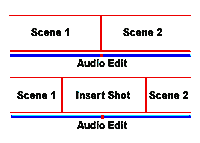 noticeable
jump in the video of the person speaking. One solution, illustrated here, is to
insert a three- or four-second cutaway shot over the jump in the video.
noticeable
jump in the video of the person speaking. One solution, illustrated here, is to
insert a three- or four-second cutaway shot over the jump in the video.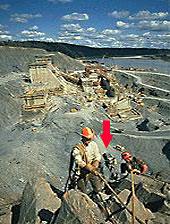

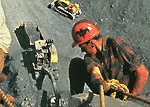



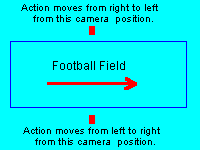 Football fans know that action on the field is reversed when the director cuts to
a camera across the field. For this reason it's never done in following a play-only
later during a replay. And then it's only justified (generally with an explanation)
if that camera position reveals something that the other cameras couldn't see.
Football fans know that action on the field is reversed when the director cuts to
a camera across the field. For this reason it's never done in following a play-only
later during a replay. And then it's only justified (generally with an explanation)
if that camera position reveals something that the other cameras couldn't see.
